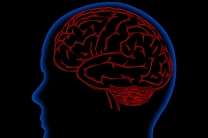Magnetic test reveals hyperactive brain network responsible for involuntary flashbacks

US scientists have found a correlation between increased circuit activity in the right side of the brain and the suffering of involuntary flashbacks by post-traumatic stress disorder (PTSD) sufferers.
Using a technique called Magnetoencephalography (MEG), which involves analysing the occurrence of magnetic charges given off when neuronal populations in our brain connect and communicate, the researchers have undertaken clinical trials to try and find differences between brain activity of PTSD sufferers and those with a clean bill of mental health.
The findings, published today, Thursday 28 October, in IOP Publishing's Journal of Neural Engineering, reveal a clear difference between the communication circuitry of sufferers and the healthy.
The trials involved 80 subjects with confirmed PTSD, many of whom suffer the affliction following military service in Vietnam, Afghanistan and Iraq, 18 subjects in PTSD remission, and 284 healthy subjects.
All participants were required to wear the MEG helmet while fixating on a spot 65 cm in front of them for 60 seconds.
The researchers from the Minneapolis Veterans Affairs Medical Center and the University of Minnesota, led by Apostolos P Georgopoulos and Brian Engdahl, found a difference between communication in the temporal and parieto-occipital right hemispheric areas of the brain. The temporal cortex, in accordance with earlier findings on the effects of its electrical stimulation during brain surgery, is thought to be responsible for the re-living of past experiences.
Of particular interest to the scientists however is that the brains of the sufferers were in this hyperactive state despite no immediate external stimulation, as the trial subjects were purposefully put into a 'task-free state'.
The researchers write, "Remarkably, the differences we found between the PTSD and the control groups were documented in a task-free state. Without evoking traumatic experiences, and, therefore, reflects the status of steady-state neuronal interactions."
The research is one further step in the attempt to 'biomark' PTSD, particularly as the results gathered from subjects in remission followed a similar but less pronounced pattern to those with PTSD confirmed as their primary diagnosis, in contrast to the healthy subjects.
More information: iopscience.iop.org/1741-2552/7/6/066005














